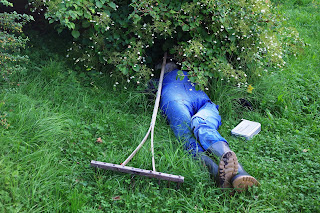I struggle to fall asleep, and regret the fact that I didn't fall asleep faster when I wake up in the morning. I know that sleep is important for muscle growth and after finding the best ways to get more zzz's with the limited time that I have, I thought it would be a good idea to share them with you.
How to fall asleep better
1. Establish a routine
Spend the last hour before you plan to sleep doing the things that will calm you down and get your body to realize that it is sleepy time. Your body is very routine-orientated. If you are used to struggling to fall asleep every night, your body will get used to that idea and will do that all the time. By doing things that make you calm down every night, your mind will start to learn that these things mean that it is time to fall asleep soon. Don't do things that you do during the rest of the day when you are wide awake. This makes your mind assume that it nowhere near bed time yet. Our ancestors did not hunt before they were going to sleep. You shouldn't either.
The bright lights from computer screens, televisions and mobile phones mimic the sun's rays to your brain. Cut these out during the last hour of your day, avoid other bright lights and your body will soon see this as a sign to start winding down. When you switch off the light and jump into bed, your mind still needs to adjust to the fact that 'it is no longer day'.
Unfortunately, our brains can't just switch off. We need to give them time to do so. If you can get your mind to relax before you climb into bed, you will fall asleep faster and the quality thereof will improve.
You quality of sleep improves because your mind was able to ease into its sleeping cycles slowly and naturally. When it is forced to wind down too quickly, it will bounce back up very soon. What goes up must come down. The faster something goes up, the faster it comes down.
2. Dim the lights
Also, our ancestors could see the sun go down every day. This subconsciously signaled bed time. Have you ever wondered why a beautiful sunset make you feel so calm and peaceful? You don't have to watch the sunset every day to get your brain to shut down, but you do need to adjust your lighting accordingly. Bright lights tell our brains that it is time to be awake and darker lighting tells us that sleep is coming soon.The bright lights from computer screens, televisions and mobile phones mimic the sun's rays to your brain. Cut these out during the last hour of your day, avoid other bright lights and your body will soon see this as a sign to start winding down. When you switch off the light and jump into bed, your mind still needs to adjust to the fact that 'it is no longer day'.
Unfortunately, our brains can't just switch off. We need to give them time to do so. If you can get your mind to relax before you climb into bed, you will fall asleep faster and the quality thereof will improve.
You quality of sleep improves because your mind was able to ease into its sleeping cycles slowly and naturally. When it is forced to wind down too quickly, it will bounce back up very soon. What goes up must come down. The faster something goes up, the faster it comes down.
2. Reverse psychology
Huffington Post says that you will actually fall asleep faster if you try to force yourself to stay awake. They quote a sleep study where two groups of insomniacs were tested. One group was told to lie in bed with their eyes wide open and stay awake. The other group was told to fall asleep as quick as they can. The group who tried to stay awake ended up falling asleep long before the group that was trying to fall asleep in the first place.
Why does reverse psychology makes our minds do what the opposite of what we are trying to do? My guess is that it is the body's way of balancing itself out.
Why does reverse psychology makes our minds do what the opposite of what we are trying to do? My guess is that it is the body's way of balancing itself out.
3. The timed breathing technique
Alina Gonzalez from Byrdie explains how she stumbled upon a breathing technique that drastically changed her life. She now uses timed breathing to fall asleep. She discovered this technique a few days before an important wedding that caused her anxiety. Her friend, a wellness practitioner, introduced her to a technique that enabled her to fall asleep within minutes. Here's how it works:
You breathe in through your nose for 4 seconds (counting as you do), hold your breath for 7 and exhale through your mouth for 8. Doing this repeatedly calms your mind and slows down your heart rate.
When you are anxious, your heart rate increases. This increases your breathing rate. The more you breathe in and out, the more anxious your body feels. This becomes a cycle that can often be hard to break out of. By slowing your breathing down and focusing on these numbers, you are forcing your body to reduce its heart rate - which in turn slows your mind and body down. This deeply relaxes you and lulls you into a deep sleep.
Alina also writes about how she used this breathing technique (with the same second counts) to combat anxiety before a major speech that she had to give on the actual wedding day. This made her feel relaxed and, according to her, allowed her to give a better speech than what she would have if she did not use this technique. Give it a try for yourself and see if it works.
4. Take a hot bath before bed time
This is suggested by wikihow.com. According to them, increasing skin temperature relaxes you and makes you feel sleepy. By taking a hot bath before bed, you will be calmer and fall asleep faster. They say that a hot shower can also work, as long as the water is above 100 degrees Fahrenheit (or 38 degrees Celsius) and as long as you stay in the water for 20 minutes or more. These temperature and time rules apply to both bathing and showering. For best results, you should bath like this 30 minutes before you plan to fall asleep.
Since the body falls asleep at cooler temperatures and wakes up at warmer temperatures (note how we can all sleep forever during winter), the hot temperature from the bath or shower makes our bodies drop their natural temperatures very quickly. This quick drop in body temperature eases us onto a quicker sleep.
Since the body falls asleep at cooler temperatures and wakes up at warmer temperatures (note how we can all sleep forever during winter), the hot temperature from the bath or shower makes our bodies drop their natural temperatures very quickly. This quick drop in body temperature eases us onto a quicker sleep.
5. The best dinner for the best sleep
Life Hack recommends eating a light meal at night for the best results. They say that eating a meal that is too heavy will burden digestion and therefore make it harder for you to fall asleep. On the other hand, going to bed hungry will stop you from dozing off as well. Eating a meal that is not too heavy but satisfies your hunger is the best, according to Life Hack. They recommend snacks like a banana, hummus or Greek yogurt before bed as the best choices.
I assume that this does not apply to everybody. I personally find that I sleep better after a big meal. Because my primary goal is to build muscle, I have a large dinner and a big meal replacement shake before bed.
I know that some people are worried about the health effects of eating before bed, but doing so actually helps people who get up to eat in the middle of their sleep cycle. This link explains how eating when you are supposed to be sleeping is worse than eating before you fall asleep.
I know that some people are worried about the health effects of eating before bed, but doing so actually helps people who get up to eat in the middle of their sleep cycle. This link explains how eating when you are supposed to be sleeping is worse than eating before you fall asleep.
6. Write it down
If troubling thoughts are keeping you from lala land, try writing down the things that you are worried about. This helps you to mentally let go of the thoughts that you can't seem to get rid of. Writing down your worries will release some of the holds that they have on your ability to relax and rest. These things always sound crazy until you try it. The next time anxiety is stopping you from falling asleep, write down whatever is making you feel anxious. Go back to bed and feel relieved. It is almost like tricking your mind into thinking that you have dealt with the issue that it needed you to handle. This amazing sleep tip was originally suggested by Daily Burn. They also recommended the 4-7-8 breathing technique we spoke about earlier - looks like that technique is causing quite a buzz.7. Tense and release
I used to do this when I was younger - and it actually helped. Mirror recommends consciously tensing and relaxing your muscles to calm yourself down. This relaxes your body and mind at the same time. Tensing your muscles before relaxing them is also a great way to release tension caused by exercise or an injury. By releasing tension and relaxing your physical body, you will be able to laze into that coveted dream state in no time. Focusing on one muscle at a time is best. Start with your toes (you can do all your toes at once), and your feet, then your calves until you get to your neck and your forehead. By the time you are done, will feel like sloppy spaghetti.
Sleep is extremely important for optimum health. Failure to fall asleep can often stress us out if we know that we only have a certain amount of time before we need to get up. By making sure that we are calm before snooze time, we will sleep sooner and get more out of every hour. STAY STRONG!
 |
| Support our website and buy this awesome Tank Top. |


































